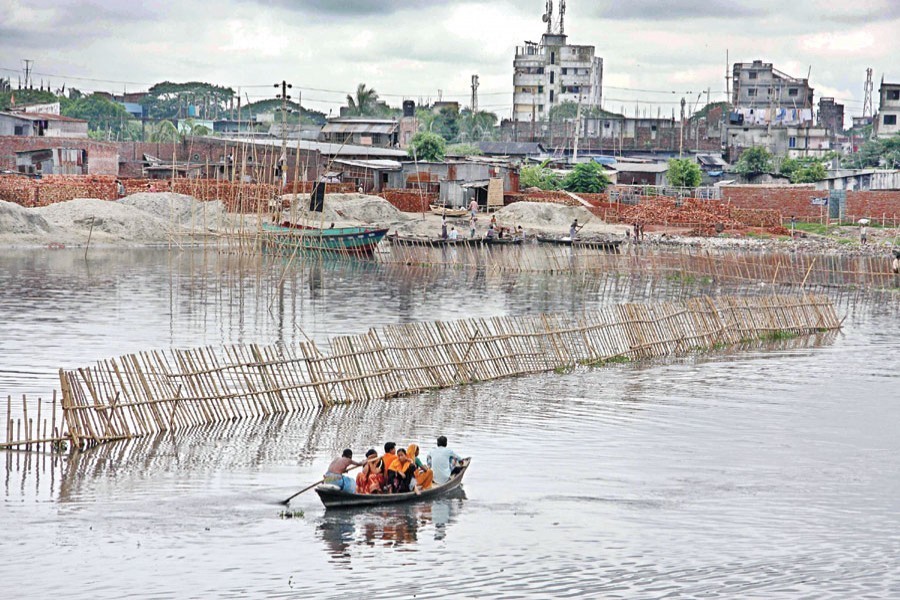The government is drafting a master plan to protect the country's rivers. According to reports, efforts are underway to protect four rivers initially. These are the Buriganga, Balu and Sitalakhya in Dhaka and the Karnaphuli in Chattogram from pollution and encroachment.
Experts say the government will draw up three, five and ten-year plans to protect the country's rivers. The master plan will also look into issues including the sewerage system and waste management. As of now, most of the country's rivers are polluted and have been grabbed in the absence of proper monitoring.
The immediate requirement is that concerted efforts should be given to protect rivers from encroachment. The budget of the master plan will be decided upon completion of the plan. The government says it would implement all the options available to give the city dwellers a relief by keeping the problem at a tolerable level.
Immediate conservation efforts including registering all the remaining rivers crisscrossing the country are very crucial as the rivers are vanishing from the map. Moreover, unilateral water withdrawal by numerous hydroelectric projects in India, Bhutan and China had already made major river basins vulnerable including the Brahmaputra and Surma-Kushiara.
Anticipating a major disaster, Prime Minister Sheikh Hasina asked the concerned ministry to work out a master plan immediately for every upazila for protecting the rivers, cultivable land and checking the unplanned construction of buildings, roads and houses.
River experts, on the other hand, underline the need for streamlining the government's river saving initiatives as the major river basins in the country are made vulnerable due to unilateral water withdrawal by the upstream countries. In order to ensure benefits of rightful share, they say, there is the crucial need for effective negotiations among the upstream and downstream countries.
On the other hand, an effective commission with necessary legal instruments could check riverbank encroachment by influential quarters. Many a times, the government took up dredging projects to regain navigability of the drying up rivers. The move was aimed at removing faulty stretches of roads, dams, privately built structures disturbing the natural flow of the rivers. But most of the initiatives ended in failure.
Very recently, the country's top judiciary has given a landmark judgment in an attempt to save the country's rivers and water bodies from illegal encroachment and pollution. A High Court bench declared rivers as legal entities and assigned the National River Protection Commission (NRPC) as the 'legal guardian' in protecting the rights of water bodies, canals, swamps, shorelines, hills and forests.
The ruling given early this month was in response to a petition by the organisation Human Rights and Peace for Bangladesh on illegal encroachment of the Turag River near capital Dhaka. The court declared that any person encroaching on rivers and water bodies should be barred from contesting elections and receiving bank loans. It also ordered the government to amend laws and give 'harsh punishment' to encroachers and polluters of rivers.
The court asked the government to form a digital database of water bodies by using satellites to promote awareness campaigns in all education institutes and to make a list of those who encroached and built illegal structures. Environmentalists and activists believe the court judgment on river protection was long overdue. This is a landmark judgment but it will require strong political commitment to implement, they say. In the past, there were indiscriminate encroachment and pollution of rivers and water bodies with political patronage.
According to statistics, the country had about 700 rivers four decades ago but today only about 400 exist. At the time of the country's liberation, total length of rivers and water bodies was 24,000 kilometers which now has reduced to little more than 3,000 kilometres.
A large number of rivers in the country, including the Buriganga, Shitalakkhya, Dhaleshwari, Turag and Balu are in dire straits. Exact data are not available, but environmentalists and journalists working on the issue say that most rivers in the country face serious threat because of ruthless grabbing and pollution.
In a 2009 judgment, the HC detailed measures to recover the ailing Dhaka rivers from land grabbers and save them from pollution. At that time, the court ordered the district administration to demarcate the boundary of the Buriganga, Shitalakkhya, Dhaleshwari, Turag and Balu.
This apparently turned out to be the "death warrant" for the rivers. Demarcation pillars were set up along the river banks during the lean flow of dry season, excluding some 2,500 acres of foreshores and wetlands of the five rivers. Now, under a new project, the government will install some 12,000 demarcation pillars along the Dhaka rivers and build some 50km long walkways, plant trees along the walkways and set up three eco-parks at Shinnirtek, Tongi and Ashulia.
Saving rivers and water bodies is an uphill task. In most cases, encroachers and polluters are politically and financially influential persons. Such an uphill battle can only be won if there is a strong political commitment and social movement to save rivers and water bodies.


